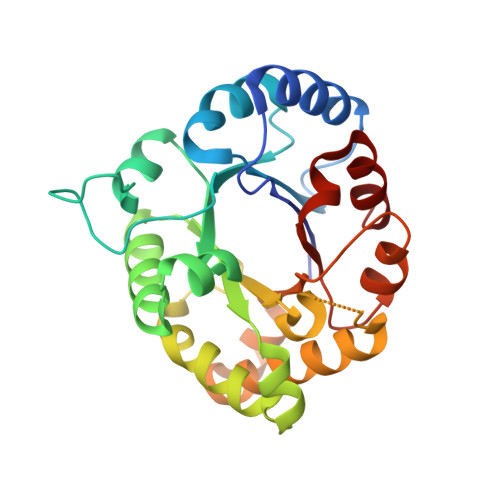Revisiting the mechanism of the triosephosphate isomerase reaction: the role of the fully conserved glutamic acid 97 residue
Samanta, M., Murthy, M.R.N., Balaram, H., Balaram, P.(2011) Chembiochem 12: 1886-1896
- PubMed: 21671330
- DOI: https://doi.org/10.1002/cbic.201100116
- Primary Citation of Related Structures:
3PSV, 3PSW - PubMed Abstract:
An analysis of 503 available triosephosphate isomerase sequences revealed nine fully conserved residues. Of these, four residues-K12, H95, E97 and E165-are capable of proton transfer and are all arrayed around the dihydroxyacetone phosphate substrate in the three-dimensional structure. Specific roles have been assigned to the residues K12, H95 and E165, but the nature of the involvement of E97 has not been established. Kinetic and structural characterization is reported for the E97Q and E97D mutants of Plasmodium falciparum triosephosphate isomerase (Pf TIM). A 4000-fold reduction in k(cat) is observed for E97Q, whereas the E97D mutant shows a 100-fold reduction. The control mutant, E165A, which lacks the key catalytic base, shows an approximately 9000-fold drop in activity. The integrity of the overall fold and stability of the dimeric structure have been demonstrated by biophysical studies. Crystal structures of E97Q and E97D mutants have been determined at 2.0 Å resolution. In the case of the isosteric replacement of glutamic acid by glutamine in the E97Q mutant a large conformational change for the critical K12 side chain is observed, corresponding to a trans-to-gauche transition about the Cγ-Cδ (χ(3)) bond. In the E97D mutant, the K12 side chain maintains the wild-type orientation, but the hydrogen bond between K12 and D97 is lost. The results are interpreted as a direct role for E97 in the catalytic proton transfer cycle. The proposed mechanism eliminates the need to invoke the formation of the energetically unfavourable imidazolate anion at H95, a key feature of the classical mechanism.
- Molecular Biophysics Unit, Indian Institute of Science, Bangalore-560012, India.
Organizational Affiliation:


















